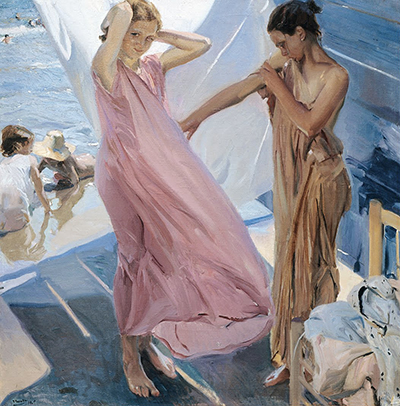This painting was done in 1909 as a reflection of real-life themes present in Valencia during that late period. It was a time when children from working-class families would bathe and play naked in the sea.
However, when the girls were four or five years old, there were required to start using gowns, while the boys continued bathing naked until adolescence. The painting shows girls changing out of their bathing gowns, while we can also see other children playing at the sea. Sorolla uses a playful style as he focuses on how light interacts with the sea and the shiny wooden surface the girls are standing on. In this painting, Sorolla juxtapositions the various colors of blues, whites, and pinks to create a harmonious whole. He also masterfully depicts the interplay between the sun and water in an imaginative and believable way.
Spain is a country renowned for its sunny beaches and water scenes, and Sorolla was one of its famous artists to depict its beauty. While Sorolla was born and raised in Valencia, he spent almost four years at Rome studying, and also made constant field travels to Paris. He held exhibitions in big cities such as New York, Berlin, St Louis, and Chicago. Some of his early influences included Anders Zorn, Adolphe von Menzel, Jule Bastien-lepage, and Vicente Blasco Ibanez. While his earlier works of portraits and social realism themes made him well-known, he would later consider them as too sentimental. This resulted in Sorolla seeking another path of painting outdoors. Sorolla would go on to make a name for himself through the masterful depictions of Valencia's Mediterranean and unique Spanish traditions.
The After Bathing, Valencia painting came at one of his most productive years between 1905 and 1910. Sorolla would come back to Valencia every summer to escape the scathing heat in the capital Madrid. When Sorolla was in his youth, he spent a lot of time with Antonio Garcia Peris, a photographer who would later become his father-in-law. This resulted in Sorolla adopting photographic techniques in his paintings. For example, we can see that this painting is from an elevated view and there is no horizon. This is a photographic convention that places the observer into the role of a participant. This piece can thus be argued to capture the Spanish light in a spectacular, calm and playful manner.




